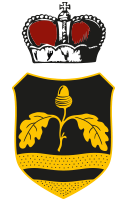14 gates
All 14 castle gates with names
- Fähnrichtor, 1580
- Wächtertor, 1577
- Nautor, 1583
- Engelstor, 1577
- Lion Gate, 1577
- Manntor, 1578
- Khevenhüllertor, 1580
- Landschaftstor, 1570
- Reisertor
- Waffentor 1576
- Mauertor, 1575
- Bridge Gate
- Church door, 1578
- Kulmertor, 1575
Fähnrichtor
Named after the flag-wielding mercenaries in the colors “black amber and red and white” (Khevenhüller and the colors), the sparse paint a fresco painting the side of the doorway reveal an artistic hand. The building itself has a special, well thought-out design. The ground floor consists primarily of two barrel-vaulted to the rear open spaces: the passage and next to a room where a gun was drawn up. The exposed staircase, under which the access is cut to a shot column, handled the marketing of the first floor and the parapet of the advanced door sections, which concerned with the support of the whole committee openings Torfront. Noble acts Torumrahmung the white limestone and green slate, with crowning a marble relief, Infant Jesus with Lamb and Flag (1580). In was only in later time from the high castle’s stone crest-derived Khevenhüller and an inscription plate (1575) fitted with a blessing. The iron-gate is still the original, it was painted and wore as a door knocker, the heavy bronze ram’s heads, which are currently stored in the collections. It is also remarkable in the lower right front corner of the walled-gray stone with the relief image of the breast Margaret Maultasch, the former Duchess of Tyrol, the saga laid siege to the castle in vain, and was forced only by a stratagem to the deduction. For several months they had besieged the castle in order to starve them, because it would be unexpected, sewn into an even more bloody bull skin, bread and other foods have been thrown from above, as a visible sign that the crew enjoys still have enough food.
The 14 goals, protect the castle path are, as already stated, the symbol of Hochosterwitz. Your very clever and technically correctly performed conditioning made the castle until clear, since the enemy had to conquer Tor Tor, but it was an attack from all sides. What was thought of everything, for example, shows the distribution of the fires that had to fire the cannons and other firearms in the time absolutely necessary. An Italian rule from 1611 reads: As the reignition by means of steel, stone, sulfur oxides and the soldiers on the outside is often quite impossible to be present at each gate and each bastion stoves with charcoal fire! It was also required to keep burning always on the guard rooms two fuses. In Hochosterwitz in this regard was taken care in the following manner: The fireplace in the second goal was also sufficient for the first and third. The fourth goal was in the associated guard towers his fireplace. The fifth goal was such a place. The goal for the sixth no longer existing fireplace in the corner bastion had to serve for this and the seventh gate. For the eighth and ninth gate a fire in the watchtower was present while the doors were supplied 10, 11, 12 and 14 without difficulty by the two fires of the gate 13th The fact that these fires and for other needs of the team were in use, needs no special mention. In the same manner as the maintenance of the fire and the holding of water for the defense was a necessity in so far as to prevent the same thing was the effect of the fires and had to be thrown also made provisions against random fires inside the fortifications. The gates and watchtowers were certainly equipped with water tanks for the purposes mentioned, sind.Zeichen of which have set up three pieces in original in the big courtyard that the crew enjoys still have enough food.
Khevenhüllertor
The most splendid of all the gates. At the elegant Renaissance setting of the arch, the keystone shows in white marble, the Khevenhüllerwappen, a lion head and 1580, also in relief the bust of the owner George Khevenhüller, armed but not wearing a helmet, holding in his right hand the baton, his left hand akimbo on his hip, the sash on the harness. George has come up here represented as army officers, the Turkish campaign in mind the year 1578, which is in Megis country’s history as recorded by the pastor Chistalnig described in detail. Similar is the view – and always with the sash – a kneeling knight of wood in natural size in the collections of the castle and the tomb lid of red marble in the parish church located in Villach relief appearance. The text of the inscription plate is mentioned on page 17. To the submission of the 7th and 8 Goal is to be noted that the terrain design with the withdrawing rock back, the far advanced steep slope and the intermediate stage the builder intended to lay the castle path to the edge of the stage and to close the doors by armored walls of the rock back and pushed bastions the low-lying plateau secure. The passage of the gate toward the front was a double-leaf doors facing the back with a large portcullis shut off, the mechanism was mounted on the upper floor, while the second floor towards the close pushed enemy from the Fußschartenschlitzen (machiculis) could be shot.

